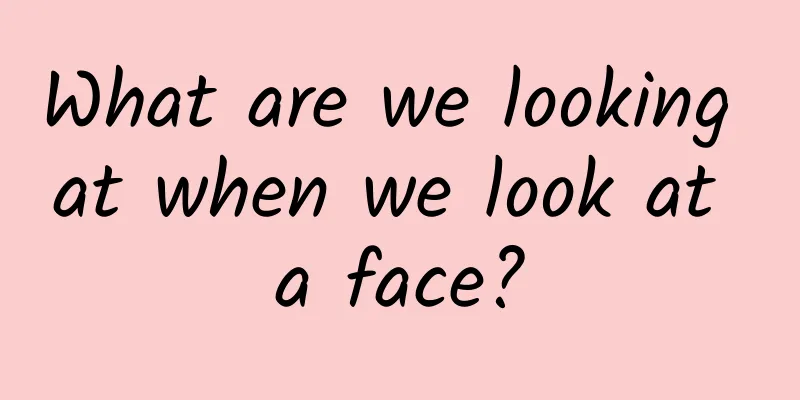What are we looking at when we look at a face?

|
Is it superficial to judge by appearance? There is actually a profound scientific basis behind it. How does the brain see faces? | Picasso paintings Author: Chen Tianzhen We humans are born experts at "looking at faces." From birth, newborns prefer to look at faces rather than other objects, like to look at familiar, beautiful faces, and enthusiastically imitate the facial expressions of others. Adults are even better at reading faces. They can easily distinguish between highly similar unfamiliar faces and can remember hundreds of faces without being affected by the passage of time. On the other hand, the speed of reading faces is also amazing - it only takes 100 milliseconds to basically grasp the gender, beauty, ugliness, happiness, anger, sadness, and joy of the face in front of them, and 200 milliseconds to complete a round of accurate analysis. We often joke that this is an era of looking at faces, and appearance is justice. But why are humans so keen on looking at faces? What are we looking at when we look at faces? What kind of face will be judged as good-looking? To answer these questions, we need to understand how the brain recognizes faces. What are we looking at when we look at a face? For highly social primates like humans, being able to recognize other individuals at a glance is crucial. When we see a strange face, our brain forms a first impression in no more than half a second, and then quickly decides whether to fight, flee, cooperate, or mate, thereby helping us avoid enemies with aggressive intentions, achieve advantageous reproduction, and communicate emotions and understand each other's thoughts. For the eyes, faces are multi-dimensional visual stimuli that provide rich information. This information can be divided into two categories: long-term features and short-term states. Long-term features are relatively persistent and stable characteristics of the face, such as whether the face in front of you is good-looking, healthy, trustworthy, etc. Short-term states are short-lived and dynamic facial clues, including information such as emotions, attention, and intentions that change at any time. Based on long-term characteristics, we can judge a person's general behavior style and whether he is worth associating with. Short-term status can show a person's attitude at the moment, allowing us to know when to seek benefits and avoid harm. How does the brain see faces? Humans are so keen on looking at faces that often anything that looks like it has two eyes, a nose, and a mouth will trigger a quick reaction in the brain to identify it as a face. This phenomenon is called pareidolia, which causes us to see faces in everything we see in life, whether it is a three-hole socket or a room with two windows and a door. We always see faces in ordinary objects. | Source: Alexander Spatari/Getty Images This natural impulse to never let go of a face even if it's wrong shows that our brains really do spare no effort in looking at faces, and it also reveals some of the mysteries of the brain's face recognition. The problem is that we often don't notice the difference between a cat or a puppy, or know who is who among a group of monkeys at the zoo, but we can instantly distinguish the countless human faces that pass by us every day. How does the brain do this? Scientists have found that when the brain recognizes a face, it does not read the eyes and nose separately and then simply piece together a face like in Picasso's abstract paintings, but rather it is a collection of multi-level information. We not only see the overall facial image - the face composed of eyes, nose, and mouth, but also capture local features such as the shape of the eyes, nose, and mouth, as well as the positional relationship between the five senses, and integrate all this information to form a complete face. In most cases, people mainly use overall information, supplemented by local information, to quickly identify who the person corresponding to the face is. The process of the brain recognizing a face is not a simple combination of facial features, but a collection of multi-level information. |Andy Warhol's painting What does a good-looking face look like? Whether we feel a person is good-looking or not is affected by many factors such as body shape, hairstyle, voice, etc., but compared with the attractiveness of a face to us, these are insignificant. In this sense, all of us are senior members of the Appearance Association. Even if it's just a few tens of milliseconds, a beautiful face is enough to make people feel moved. Is it because a beautiful face conforms to the so-called pure beauty paradigm? Or are there more complex and profound biological and social factors? Scientists who study face recognition have found that good-looking and attractive faces often reflect many of a person's physical and social traits. Humans like these traits, and over time, faces that have these traits are considered beautiful. So although sometimes it seems that the eyes have captured superficial humans as visual animals and made us willingly surrender to a person's beauty, there is actually a solid physical basis behind this. First of all, symmetry. Humans have round faces with two eyes, a nose, and a mouth from top to bottom. They are naturally symmetrical, and we are born with a love for symmetry. Experiments have found that the more symmetrical a face is, the better a person's health is. Symmetry reflects resistance to parasites and pathogens, indicating the presence of high-quality genes - just like healthy plants are often balanced and symmetrical, while plants that are attacked by pathogens tend to grow into "crooked melons and cracked dates". Secondly, average faces are better looking. Scientists have found that the average face obtained by weighted averaging a large number of real-life photos is often better looking, and the more photos there are, the better looking it is. Similar to symmetry, this averageness also reflects a person's genetic characteristics: the closer the face is to the overall average, the richer the genetic source, and the stronger the adaptability to the environment. In addition, the more obvious the secondary sexual characteristics are, the better looking they tend to be. The faces of adult men and women are very different, with men tending to have longer faces, wider chins and more distinct cheekbones. For women, the more obvious the feminine features are, the better looking they are. The relationship between male features and attractiveness is more complicated. Generally speaking, the more obvious the male features are, the better looking they tend to be, but too much masculinity can make a person look violent. For example, studies have found that when women's estrogen levels are at their peak, they tend to prefer men with strong masculine characteristics and maintain short-term relationships with them in order to obtain better genes; when hormone levels are low, they are more inclined to maintain long-term relationships with men with weak masculine characteristics in order to better raise their offspring. Faces often reflect a person's physical and social traits. | Picasso painting In fact, the faces we know are like floating in the face space of the brain, and the origin of this space is the average of all the faces we have experienced. The closer a face is to the origin, the easier it is to be considered good-looking, while a unique face is often located in a remote corner of this space. Our region, culture, and life experiences all affect our perception of beauty, and even fluctuations in hormone levels can affect our preference for beauty. From this perspective, a beautiful face is unique to each person. References: [1] Development of Face Processing. Wiley Interdiscip Rev Cogn Sci. 2011; 2(6): 666–675. doi: 10.1002/wcs.146 [2] Zhihu column "The World of Faces", author Hua Sha. Dr. Hua Sha mainly conducts research on face recognition. Interested readers can follow Hua Sha's column to learn more about face recognition. [3] https://cosmosmagazine.com/health/body-and-mind/facing-up-to-ordinary-things/ |
<<: What are fish balls made of? How to make fish balls
>>: What side dishes should be added to fish ball soup? How to make homemade fish balls
Recommend
Is the left breast nodule serious?
If breast nodules appear, the patient should not ...
How to treat postpartum disease?
If you do not pay attention to your own health du...
Endometriosis infertility causes
Infertility is a common problem nowadays. Many wo...
Women with mysophobia are difficult to get along with
How does it feel like for a man to marry a woman ...
Understanding Edema in One Article
Author: Chen Zhou Shanghai Changhai Hospital Cart...
How long does it take for a childbirth tear to heal?
Natural childbirth requires some pain, which is s...
What causes blood clots during menstruation after childbirth? Experts answer your questions
Some women find that their menstruation has chang...
This virus has entered its peak period, the latest reminder from the China Centers for Disease Control →
The peak season for norovirus infection is from O...
What foods should I eat to replenish qi and blood deficiency?
Qi and blood deficiency is a major health hazard ...
My nipples hurt when I touch them.
Many female friends find that their breasts feel ...
Why can't women have children?
The ability of women to bear children can be said...
Why does a cesarean section cause hemorrhoids?
When pregnant women develop severe hemorrhoids af...
What to do if the menstrual flow is getting less and less at 38 years old
The amount or color of menstrual blood should not...
What is the cause of the feeling of abdominal distension and pain after pregnancy?
It is very common for women to experience lower a...
What causes back pain in women?
Low back pain is a symptom. Generally speaking, t...









